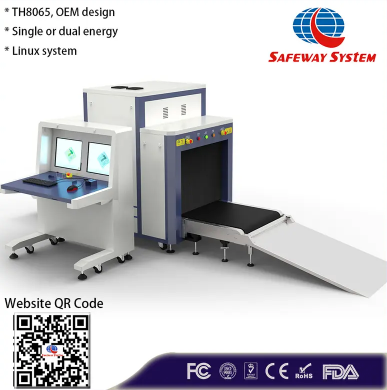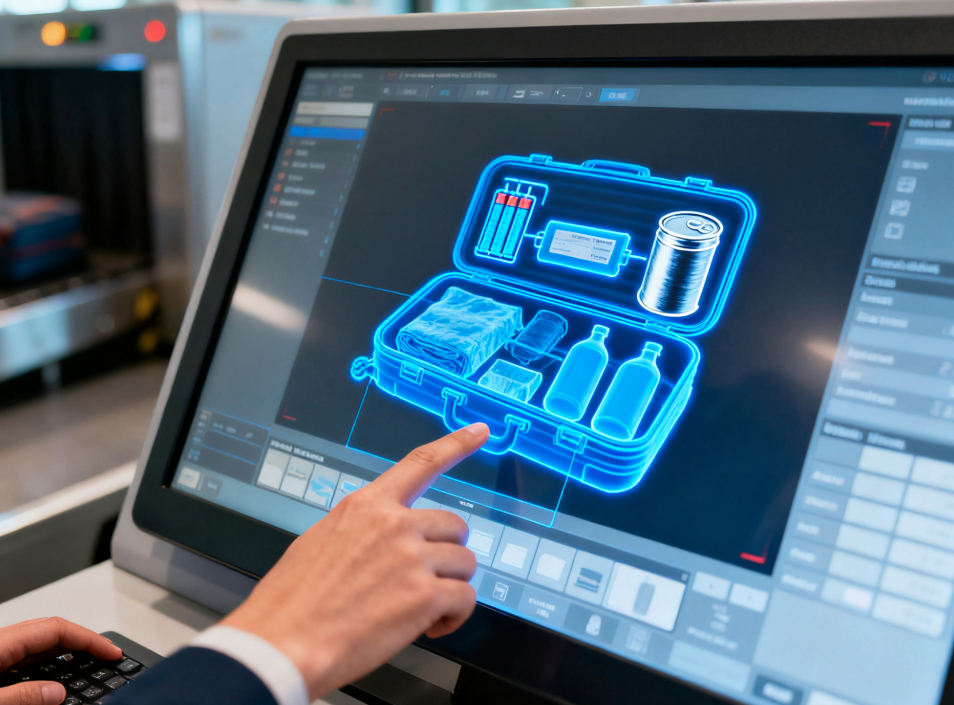Views: 2 Author: Site Editor Publish Time: 2025-09-26 Origin: Site








Security has become a top priority in today’s fast-paced world. Airports, hotels, offices, and public venues need reliable solutions to keep people and property safe. One of the most effective tools for achieving this is the X-Ray baggage scanner. They allow security staff to inspect bags and parcels without opening them, quickly identifying potential threats while maintaining smooth operations.
Understanding the basics of X-Ray baggage scanners and their must-know features can help businesses choose the right equipment and make the most of its capabilities. From image quality to user interfaces and AI-driven detection, modern scanners offer a wide range of tools that make security faster, safer, and more efficient.
An X-Ray baggage scanner is a device used to inspect bags, parcels, or luggage without opening them. It passes X-rays through the items, and detectors create images. Different materials appear in different colors: metals often show blue, organic items orange, and inorganic green.
They aren’t only for airports. Offices, mailrooms, hotels, and schools also use them. Security staff can spot threats quickly while keeping operations smooth.

X - ray baggage scanners are sophisticated devices that rely on several key components to function effectively and safely. Understanding these components can help you appreciate how these scanners work and why they are so crucial for security operations.
The X - ray tube is the heart of the scanner. It generates the X - rays that pass through the baggage, creating the images used for security checks. These tubes are designed to produce high - energy X - rays that can penetrate various materials, revealing the contents of bags and parcels.
Shielding is another critical component. Typically made of lead, the shielding prevents most of the radiation from escaping the scanner. This ensures that operators and bystanders are not exposed to harmful radiation levels. The shielding is usually integrated into the scanner’s design, with lead walls and curtains at entry and exit points to contain the radiation. This safety feature is essential for protecting both the operators and the surrounding environment.
Detectors play a vital role in capturing the X - rays that pass through the baggage. These detectors convert the X - rays into digital images that can be analyzed by security personnel. Modern detectors are highly sensitive and can capture detailed images even at high speeds.
The software used in X - ray scanners is equally important. It processes the raw data from the detectors and converts it into clear, high - resolution images. Advanced software tools allow operators to zoom in, filter, and sharpen images, making it easier to identify potential threats. Some scanners come with AI - driven software that can automatically highlight suspicious items, reducing the workload on security personnel and minimizing the risk of human error.
The conveyor system is designed to move large pieces of baggage efficiently through the scanner. This is particularly important in high - traffic areas like airports, where thousands of bags need to be screened daily. Conveyor models are equipped with robust belts and rollers that can handle heavy loads and ensure smooth operation.
For smaller items, such as parcels and packages, cabinet scanners provide a compact and efficient solution. These scanners are ideal for environments where space is limited but security is still a priority. Cabinet scanners are often used in courthouses, corporate offices, and other locations where smaller items need to be screened.
The user interface of an X - ray scanner is designed to be intuitive and easy to use. Touchscreens, simple menus, and clear alarms guide operators through the scanning process. Multi - user profiles allow different staff members to customize settings according to their roles and preferences, enhancing overall usability and efficiency.
Modern scanners often come with advanced user interfaces that include features like real - time image processing, automatic threat detection, and customizable alerts. These interfaces are designed to provide operators with the tools they need to quickly and accurately identify potential threats.
| Component | Function |
|---|---|
| X - Ray Tube | Generates X - rays for scanning |
| Lead Shielding | Prevents radiation leakage |
| Detector & Software | Converts rays into images; software tools allow zooming, filtering, and sharpening; some scanners highlight suspicious items automatically |
| Conveyor/Cabinet | Conveyor models move large baggage efficiently; cabinet scanners provide compact solutions for parcels and small packages |
| Interface & Alarms | Touchscreens, easy menus, and alarms guide operators; multi - user profiles support different staff members |
Modern X - ray baggage scanners come equipped with a range of advanced features designed to enhance both efficiency and safety. These features make them indispensable tools in high - security environments such as airports, government buildings, and event venues.
High - resolution imaging is a critical feature that allows operators to detect even the smallest threats. Detailed images provide clear visibility of items within baggage, making it easier to identify concealed weapons, explosives, or other prohibited items. This level of detail is particularly important in environments where security is paramount.
A multi - color display enhances the ability to differentiate between various types of materials. Metals, organic items, and inorganic items can be easily distinguished, reducing the risk of false alarms and improving the accuracy of threat detection. This feature is especially useful in complex scans where multiple materials are present.
AI - driven automatic threat detection is a game - changer in modern scanners. These systems can automatically flag potential threats such as weapons or explosives, reducing the workload on security personnel and minimizing the risk of human error. AI algorithms continuously learn and improve, making the scanner more effective over time.
The ability to zoom in and inspect specific areas of a bag is essential for detailed analysis. Operators can focus on suspicious items or areas that require closer examination, ensuring that no potential threat is overlooked. This feature enhances the overall effectiveness of the scanning process.
Modern scanners can send scans instantly to staff via email or other remote alert systems. This allows security personnel to monitor and respond to potential threats in real - time, even if they are not physically present at the scanner. Remote monitoring enhances overall security and ensures a quick response to any identified threats.
ID - based activation ensures that only authorized personnel can operate the scanner. This feature enhances security by preventing unauthorized use and ensuring that the scanner is used correctly and safely. It also supports accountability by tracking which users are operating the scanner at any given time.

The long - term costs of owning an X - ray baggage scanner are significantly influenced by its energy use and maintenance requirements. Implementing effective energy - saving measures and a robust maintenance schedule can help reduce operational costs and ensure the scanner remains in optimal working condition.
Choosing energy - efficient scanners is a smart investment that can lead to substantial savings on electricity bills over time. Modern scanners often come with advanced energy - saving features such as low - power modes and automatic shut - off when not in use. These features not only reduce energy consumption but also contribute to a more sustainable operation.
Regular calibration is essential for maintaining the accuracy of the scanner’s images. Calibration ensures that the X - ray tube and detectors are functioning correctly, providing clear and reliable images. This is crucial for effective threat detection and minimizes the risk of false alarms or missed threats. Calibration should be performed by trained technicians to ensure precision and compliance with safety standards.
Having easy access to spare parts is vital for minimizing downtime. Unexpected failures can disrupt operations, leading to delays and increased costs. By ensuring that spare parts are readily available, either through a reliable supplier or an on - site inventory, you can quickly replace faulty components and keep the scanner running smoothly.
Local technical support is invaluable for speeding up repairs and troubleshooting. In the event of a malfunction, having access to nearby technicians who are familiar with the scanner’s technology can significantly reduce downtime. Local support also ensures that any issues are resolved promptly, minimizing the impact on your operations.
Implementing a structured maintenance schedule can help you stay on top of your scanner’s upkeep. Here’s an example of a maintenance schedule that covers key tasks:
| Task | Frequency | Notes |
|---|---|---|
| Calibration | Every 6 months | Ensures accurate image capture and reliable threat detection. |
| Filter Cleaning | Monthly | Keeps the scanner’s imaging system clear and free from dust or debris. |
| Software Updates | As released | Installs the latest features and security patches to enhance performance. |
| Spare Part Inspection | Quarterly | Checks for wear and tear, ensuring that critical components are in good condition. |
Consider typical baggage or package sizes. Cabinets for small parcels, conveyors for large volumes.
Most weapons, explosives, and suspicious items are detectable, especially with AI-assisted detection.
Operators should learn to interpret images and use alarms correctly.
Yes. Many models can email scans or send instant notifications to staff.
Choosing the right X-Ray baggage scanner is essential for protecting people and property in any environment. By focusing on image clarity, automatic threat detection, energy efficiency, and user-friendly interfaces, businesses can ensure security measures are both effective and reliable.
For organizations looking for professional solutions, Safeway Inspection System Company Limited provides a wide range of high-quality X-Ray scanners. Their devices combine advanced technology, robust safety features, and expert support, helping businesses maintain security while optimizing operational efficiency.
0086 13670213490